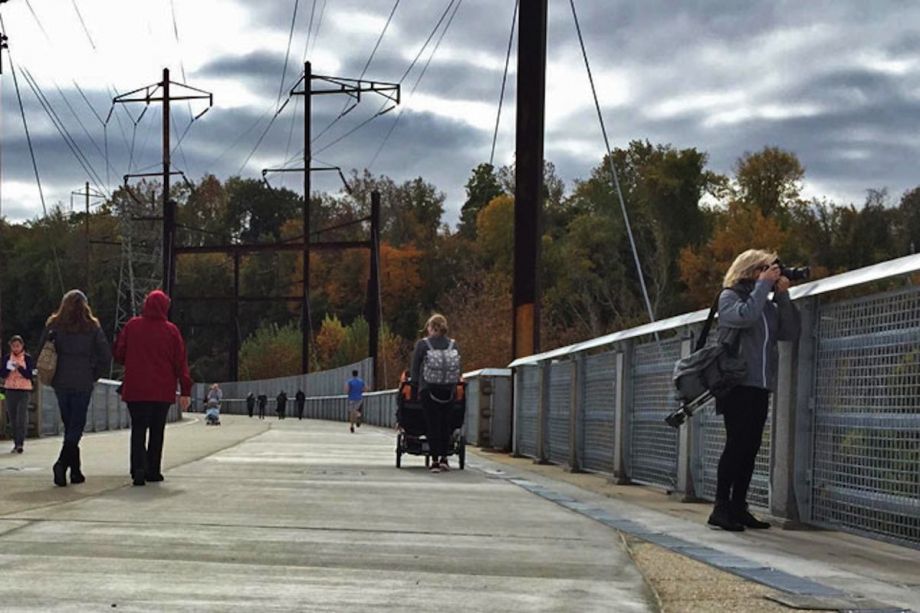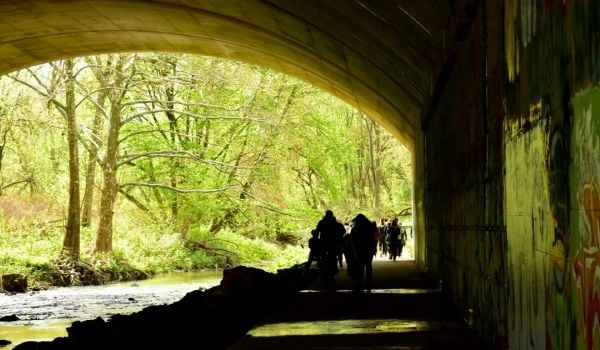Ever since trains stopped running over it in 1986, Philadelphia’s Manayunk Bridge, spanning the Schuylkill River, has been a glimmer in the eyes of rails-to-trails activists. They saw a potential recreational trail — and a major bicycle commuter route.
When the bridge’s owner, the Southeastern Pennsylvania Transportation Authority, finally removed the tracks from the bridge in 2008, the glimmer suddenly became a very real possibility.
The trouble was, turning the old railroad into a trail wasn’t as simple as just laying down pavement where crushed rock used to be. For starters, there were many different actors that needed to sign off on the idea: three governments, two communities and a transportation agency shared responsibility for the bridge and the paths leading up to it.
Last month, representatives of all those — suburban and urban — as well as a bicycle advocacy group, celebrated the completion of the trail project. In an era when even relatively simple projects not requiring intergovernmental cooperation can take a decade or more to move from concept to ribbon-cutting, the speed with which all the pieces fell into place to build the Manayunk Bridge Trail is remarkable.
“This Is a Good Idea. Let’s Do It.”
One key to the project: In 2006, people in suburban Lower Merion Township were already thinking about converting a portion of the former regional rail line into a recreational and commuter trail.
“In 2007, the township and Montgomery County approached SEPTA about converting the rail line to a trail,” says Chris Leswing, Lower Merion Township planner. “The head of SEPTA’s real estate department stopped the meeting, closed the door, and told us, ‘You know, I deal with a lot of terrible ideas. This is a good idea. Let’s do it.’ It was love at our first meeting with SEPTA.”
Work on the trail in Lower Merion proceeded quickly from that point. After SEPTA removed the track in 2008, the township leased the unused right-of-way, including the Manayunk Bridge, from SEPTA, and volunteers worked with SEPTA staff to clear away underbrush and ready the path for conversion into a paved biking and hiking trail. That trail, the Cynwyd Heritage Trail, opened in 2011.
Meanwhile, on the opposite bank of the Schuylkill River, community groups around Philadelphia’s Manayunk neighborhood had similar ideas. The concrete arch bridge is a landmark that identifies Manayunk, and the local community development corporation had been following with interest plans to expand recreational trails. One of the major bicycle trails in the region, the Schuylkill River Trail, goes through the heart of Manayunk.
“Chris was an advocate for this project,” says Kay Sykora, director of the Manayunk Development Corporation’s Destination Schuylkill River program. “He used to bring groups of people across the bridge as it was.” One of those travelers was Sarah Clark Stuart, who’s now executive director of the Bicycle Coalition of Greater Philadelphia, and who says she “had been working on the trails that run through Manayunk for a while, so this was a natural.”
Two River Banks, One Goal
At about the same time, two citizen advocacy groups formed on the opposite banks of the river to raise awareness of the trail’s potential. Friends of the Cynwyd Heritage Trail in Lower Merion and Ivy Ridge Green in Philadelphia both shared the goal of turning the abandoned railroad right-of-way in their communities into a bike and pedestrian trail, and the bridge would be the link that made the chain work. (The Bicycle Coalition had also identified another nearby crossing, the Pencoyd Bridge, that could tie together trails on both banks of the Schuylkill. The group worked with the private owner of a former steel mill on the Montgomery County side to add bike and pedestrian facilities to the old railroad bridge, to which the land owner built trails and a trailhead parking facility. These too would be connected to the larger Schuylkill River Trail network via the Manayunk Bridge project.)
Stuart realized as the preliminary work progressed in Lower Merion that the bridge conversion would need the support of multiple actors. She got to work bringing them together. The first step was forming the “Complete the Trail” campaign, which brought together advocacy groups and governments on both banks in 2009, to push for a network of trail projects all along the Schuylkill. The campaign led to a bill in Philadelphia City Council calling for the formation of “a working group of city, state and federal lawmakers and interested parties to look for money to complete the Schuylkill River Trail.”
That working group in turn came up with a grant application in 2010 that bundled together 17 different trail construction projects in six counties. The federal government awarded a TIGER grant that covered 10 of those projects in Philadelphia and the nearby New Jersey city of Camden. However, the Manayunk Bridge trail project was not among those 10, as it was considered a Montgomery County project. But any disappointment Manayunk Bridge trail advocates may have felt proved short-lived, for after the grants were announced, Philadelphia Mayor Michael Nutter and Montgomery County Commissioner Joe Hoeffel, who was also chair of the Delaware Valley Regional Planning Commission (DVRPC), the Philadelphia region’s metropolitan planning organization for transportation, met to discuss projects of regional significance and agreed that the conversion of the Manayunk Bridge to a trail was one they should pursue together.
Their agreement touched off a four-year process that both cobbled together funding to build the bridge trail without federal money and worked toward a design that would satisfy the chief goal of those who first thought putting a trail across the bridge would be a good idea.
That latter quest wasn’t as simple as it might seem either.
“The main thing we had to sort out in the beginning was that there was this love affair with the High Line,” Sykora says. “But our primary goal for this was as a bike trail, which was a much more active use. Once we got that sorted out, people really began to work together.”
A similar dynamic was at work on the opposite riverbank. “The project just had a lot of magic,” says Leswing. “It had a personal connection to a lot of people.” Many suburban residents saw its potential as a recreational asset and a way to reach Manayunk’s bars, restaurants and shops while enjoying a spectacular view.
But Leswing notes, “This was never meant to be just a little park. This is about connecting our township to the emerging 21st-century transportation network, which is the regional rail network.”
With everyone agreeing on the main reason for converting the bridge, both political support and funding fell into place with unusual ease and speed for a project with so many moving parts.
Funding for design work came from the William Penn Foundation and the Pennsylvania Department of Conservation and Natural Resources (DCNR), which oversees the state park system. Additional funding came from the Pennsylvania Department of Transportation’s Pennsylvania Community Transportation Initiative (PCTI), and both Montgomery County and the City of Philadelphia chipped in money from funds for congestion management and recreational facilities. Finally, SEPTA leased the bridge to the City of Philadelphia in order to bring the bridge under the control of the same agency that manages the Schuylkill River Trail in the city, the city’s Parks and Recreation department.
“Lower Merion Township, Montgomery County, the City of Philadelphia, the DVRPC, the DCNR, the William Penn Foundation and SEPTA were all committed to seeing this project through,” Stuart says. Nonetheless, “there was always an issue of making sure enough money was available to pay for it, and that all the clearances and permissions were in order.” And so on.
Turning on the Lights
The whole conversion project took four years to get from agreement in principle to fact on the ground. “Getting all the partners together in that short a time required a huge commitment on the part of all the actors,” Stuart says.
Work still needs to be done. The bridge isn’t yet the linchpin of that 21st-century commuter route Leswing envisions. Trails connecting the bridge to the Schuylkill River Trail need to be completed on the Philadelphia side. (Some funding is already in place for that.) The trails connecting the span to the Pencoyd Bridge are still in the process of becoming; the private owner of the land on either side of the bridge is handling that along with upgrading the bridge for bike and pedestrian use.
And the main item remaining on the to-do list is lighting the bridge, which currently closes at sunset because it is unlit. “The cost of adding lighting to the bridge was more than the funds that could be raised, so it is not lit now,” Stuart says. However, conduits for power cables for the lights were included in the bridge design, so adding them is a mere matter of finding the money.
Demand for more open hours is certainly there, waiting to be satisfied: With nearly 115,000 users in the last year, the Cynwyd Heritage Trail is one of the five busiest trails on the network of regional biking/hiking trails collectively known as “the Circuit,” and traffic on the Schuylkill River Trail itself is even higher. With its easier grade, the Manayunk Bridge and its connecting trails could turn even more residents of Philadelphia’s northwest area into bike commuters. The coalition that made the bridge trail happen only needs to turn the lights on — and they’re working on it.

Next City contributor Sandy Smith is the home and real estate editor at Philadelphia magazine. Over the years, his work has appeared in Hidden City Philadelphia, the Philadelphia Inquirer and other local and regional publications. His interest in cities stretches back to his youth in Kansas City, and his career in journalism and media relations extends back that far as well.
Follow Sandy .(JavaScript must be enabled to view this email address)
















